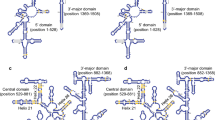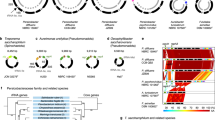Abstract
All members of the genera Haloarcula and Halomicrobium whose names have been validly published were surveyed for 16S rRNA gene polymorphism, and the transcription of the genes from two species was investigated during growth at different NaCl concentrations. The species of Haloarcula and Halomicrobium harbour at least two different 16S rRNA gene copies, and 18 new sequences of 16S rRNA genes were obtained. The type I and type II 16S rRNA genes of Haloarcula are divergent at 4.8–5.6% of their nucleotide positions. The type III and type IV 16S rRNA genes from Halomicrobium mukohataei JCM 9738T are 9.0% divergent, which represents the highest intraspecific divergent 16S rRNA genes so far seen. Phylogenetic analysis based on 16S rRNA genes indicated that all type I 16S rRNA genes were clustered, and the same was true for the type II 16S rRNA genes of Haloarcula species. The two clusters, respectively generated from type I and type II 16S rRNA genes, were sharply separated and their divergences (4.8–5.6%) are in the range of various divergence usually found between genera in the order Halobacteriales (about 5–10%). Results from reverse transcription-PCR showed that the type I and type II copies of Har. amylolytica BD-3T and type III and type IV copies of Hmc. mukohataei JCM 9738T were all transcribed to 16S rRNA molecules under different salt concentrations (15–28% NaCl).




Similar content being viewed by others
References
Amann G, Stetter KO, Llobet-Brossa E, Amann R, Antón J (2000) Direct proof for the presence and expression of two 5% different 16S rRNA genes in individual cells of Haloarcula marismortui. Extremophiles 4:373–376
Baliga NS, Bonneau R, Facciotti MT, Pan M, Glusman G, Deutsch EW, Shannon P, Chiu Y, Weng RS, Gan RR, Hung P, Date SV, Marcotte E, Hood L, Ng WV (2004) Genome sequence of Haloarcula marismortui: a halophilic archaeon from the Dead Sea. Genome Res 14:2221–2234
Boucher Y, Douady CJ, Sharma AK, Kamekura M, Doolittle WF (2004) Intragenomic heterogeneity and intergenomic recombination among haloarchaeal rRNA genes. J Bacteriol 186:3980–3990
Burns DG, Janssen PH, Itoh T, Kamekura M, Li Z, Jensen G, Rodríguez-Valera F, Bolhuis H, Dyall-Smith ML (2007) Haloquadratum walsbyi gen. nov., sp. nov., the square haloarchaeon of Walsby, isolated from saltern crystallizers in Australia and Spain. Int J Syst Evol Microbiol 57:387–392
Carranza S, Giribet G, Riberat C, Baguna J, Riutort M (1996) Evidence that two types of 18S rDNA coexist in the genome of Dugesia (Schmidtea) mediterranea (Platyhelminthes, Turbellaria, Tricladida). Mol Biol Evol 13:824–832
Case RJ, Boucher Y, Dahllöf I, Holmström C, Doolittle WF, Kjelleberg S (2007) Use of 16S rRNA and rpoB genes as molecular markers for microbial ecology studies. Appl Environ Microbiol 73:278–288
Clayton RA, Sutton G, Hinkle PS Jr, Bult C, Fields C (1995) Intraspecific variation in small-subunit rRNA sequences in GenBank: why single sequences may not adequately represent prokaryotic taxa. Int J Syst Bacteriol 45:595–599
Cole JR, Chai B, Marsh TL, Farris RJ, Wang Q, Kulam SA, Chandra S, McGarrell DM, Schmidt TM, Garrity GM, Tiedje JM (2003) The Ribosomal Database Project (RDP-II): previewing a new autoaligner that allows regular updates and the new prokaryotic taxonomy. Nucleic Acids Res 31:442–443
Crosby LD, Criddle CS (2003) Understanding bias in microbial community analysis techniques due to rrn operon copy number heterogeneity. Biotechniques 34:790–794
Dennis PP (1999) Expression of ribosomal RNA operons in halophilic archaea. In: Oren A (ed) Microbiology and biogeochemistry of hypersaline environments. CRC Press, Boca Raton, pp 319–329
Dennis PP, Shimmin LC (1997) Evolutionary divergence and salinity-mediated selection in halophilic archaea. Microbiol Mol Biol Rev 61:90–104
Felsenstein J (1985) Confidence limits on phylogenies: an approach using the bootstrap. Evolution 39:783–791
Gemmell RT, McGenity TJ, Grant WD (1998) Use of molecular techniques to investigate possible long-term dormancy of halobacteria in ancient halite deposits. Ancient Biomol 2:125–133
Gunderson JH, Sogin ML, Wollett G, Hollingdale M, de la Cruz VF, Waters AP, McCutchan TF (1987) Structurally distinct, stage-specific ribosomes occur in Plasmodium. Science 238:933–937
Harth E, Romero J, Torres R, Espejo RT (2007) Intragenomic heterogeneity and intergenomic recombination among Vibrio parahaemolyticus 16S rRNA genes. Microbiology 153:2640–2647
Ihara K, Watanabe S, Tamura T (1997) Haloarcula argentinensis sp. nov. and Haloarcula mukohataei sp. nov., two new extremely halophilic archaea collected in Argentina. Int J Syst Bacteriol 47:73–77
Kimura M (1980) A simple method for estimating evolutionary rate of base substitutions through comparative studies of nucleotide sequences. J Mol Evol 16:111–120
Kumar S, Tamura K, Nei M (2004) MEGA3: Integrated software for molecular evolutionary genetics analysis and sequence alignment. Brief Bioinform 5:150–163
López-López A, Benlloch S, Bonfá M, Rodríguez-Valera F, Mira A (2007) Intragenomic 16S rDNA divergence in Haloarcula marismortui is an adaptation to different temperatures. J Mol Evol 65:687–696
Marchandin H, Teyssier C, Simeon De Buochberg M, Jean-Pierre H, Carriere C, Jumas-Bilak E (2003) Intra-chromosomal heterogeneity between the four 16S rRNA gene copies in the genus Veillonella: implications for phylogeny and taxonomy. Microbiology 149:1493–1501
Mylvaganam S, Dennis PP (1992) Sequence heterogeneity between the two genes encoding 16S rRNA from the halophilic archaebacterium Haloarcula marismortui. Genetics 130:399–410
Ng WL, Yang CF, Halladay JT, Arora P, DasSarma S (1995) Protocol 25: isolation of genomic and plasmid DNAs from Halobacterium halobium. In: DasSarma S, Fleischmann EM (eds) Archaea: a laboratory manual: halophiles. Cold Spring Harbor Laboratory Press, Cold Spring Harbor, pp 179–180
Nieuwlandt DT, Palmer JR, Armbruster DT, Kuo YP, Oda W, Daniels CJ (1995) Protocol 23: a rapid procedure for the isolation of RNA from Haloferax volcanii. In: DasSarma S, Fleischmann EM (eds) Archaea: a laboratory manual: halophiles. Cold Spring Harbor Laboratory Press, Cold Spring Harbor, pp 161–162
Oren A, Elevi R, Watanabe S, Ihara K, Corcelli A (2002) Halomicrobium mukohataei gen. nov., comb. nov., and emended description of Halomicrobium mukohataei. Int J Syst Evol Microbiol 52:1831–1835
Saitou N, Nei M (1987) The neighbor-joining method: a new method for reconstructing phylogenetic trees. Mol Biol Evol 4:406–425
Savage KNL, Krumholz LR, Oren A, Elshahed MS (2007) Haladaptatus paucihalophilus gen. nov., sp. nov., a halophilic archaeon isolated from a low-salt, sulfide-rich spring. Int J Syst Evol Microbiol 57:19–24
Sehgal SN, Gibbons NE (1960) Effect of some metal ions on the growth of halobacterium cutirubrum. Can J Microbiol 6:165–169
Tu D, Blaha G, Moore PB, Steitz TA (2005) Gene replacement in Haloarcula marismortui: construction of a strain with two of its three chromosomal rRNA operons deleted. Extremophiles 9:427–435
Vreeland RH, Straight S, Krammes J, Dougherty K, Rosenzweig WD, Kamekura M (2002) Halosimplex carlsbadense gen. nov., sp. nov., a unique halophilic archaeon, with three 16S rRNA genes, that grows only in defined medium with glycerol and acetate or pyruvate. Extremophiles 6:445–452
Wang Y, Zhang ZS, Ramanan N (1997) The actinomycete Thermobispora bispora contains two distinct types of transcriptionally active 16S rRNA genes. J Bacteriol 179:3270–3276
Woese CR, Kandler O, Wheelis ML (1990) Towards a natural system of organisms: proposal for the domains Archaea, Bacteria, and Eucarya. Proc Natl Acad Sci USA 87:4576–4579
Yang Y, Cui HL, Zhou PJ, Liu SJ (2007) Haloarcula amylolytica sp. nov., an extremely halophilic archaeon isolated from Aibi salt lake in Xin-Jiang, China. Int J Syst Evol Microbiol 57:103–106
Yap WH, Zhang Z, Wang Y (1999) Distinct types of rRNA operons exist in the genome of the actinomycete Thermomonospora chromogena and evidence for horizontal transfer of an entire rRNA operon. J Bacteriol 181:5201–5209
Acknowledgments
This study was supported by the National Basic Research Program from the Ministry of Science and Technology (MOST) of China (Grant No. 2004CB719601) and a start-up grant from Jiangsu University (Grant No. 08JDG016).
Author information
Authors and Affiliations
Corresponding author
Additional information
Communicated by A. Driessen.
Rights and permissions
About this article
Cite this article
Cui, HL., Zhou, PJ., Oren, A. et al. Intraspecific polymorphism of 16S rRNA genes in two halophilic archaeal genera, Haloarcula and Halomicrobium . Extremophiles 13, 31–37 (2009). https://doi.org/10.1007/s00792-008-0194-2
Received:
Accepted:
Published:
Issue Date:
DOI: https://doi.org/10.1007/s00792-008-0194-2




